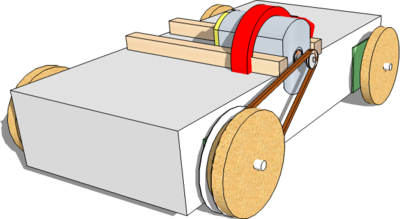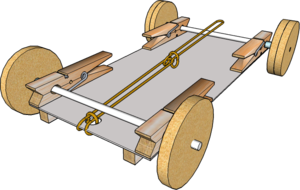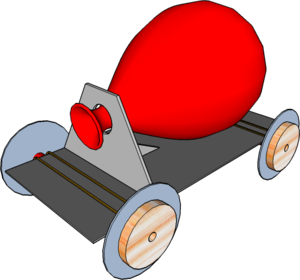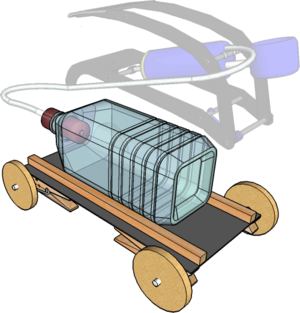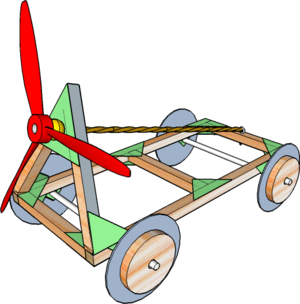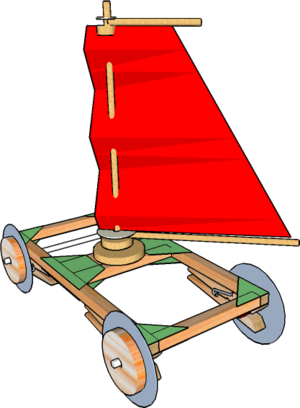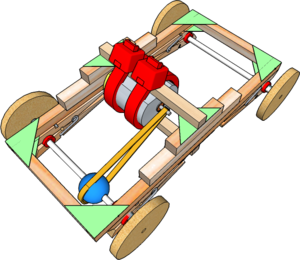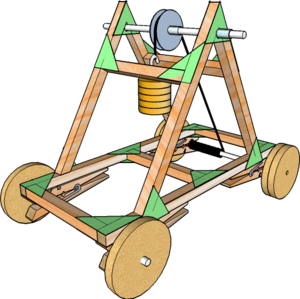Powered Vehicle: Difference between revisions
From DT Online
mNo edit summary |
mNo edit summary |
||
| (2 intermediate revisions by the same user not shown) | |||
| Line 1: | Line 1: | ||
[[File:PoweredBoxModel.png|400px|right]] | [[File:PoweredBoxModel.png|400px|right]] | ||
__TOC__ | |||
Vehicle [ | =====Description===== | ||
Model vehicles can be powered by gravity if simply rolled down a slope, but [http://en.wikipedia.org/wiki/Motive_power '''Motive Power'''] can be added to working models in a variety of other ways. | |||
Vehicle [http://en.wikipedia.org/wiki/Rolling_chassis '''Chassis'''] are chosen to illustrate several ways of adding power to a model but the same ideas can be used for many other working models. | |||
| Line 9: | Line 13: | ||
=====Features and Uses===== | |||
{| | {| | ||
|- | |- | ||
| [ | | [http://en.wikipedia.org/wiki/Rubber_band#Model_use '''Rubber Motor'''] | ||
| This elastic bands can be knotted together to lengthen them ''(and doubled or trebled to strengthen them)''. One end is fixed to the front of the '''Chassis''' and the other held against the rear axle as it is wound up ''(if it is tied on to the rear axle there will be no 'free-wheeling' after the motor is run)''. | | This elastic bands can be knotted together to lengthen them ''(and doubled or trebled to strengthen them)''. One end is fixed to the front of the '''Chassis''' and the other held against the rear axle as it is wound up ''(if it is tied on to the rear axle there will be no 'free-wheeling' after the motor is run)''. | ||
| Line 21: | Line 26: | ||
| [[File:RubberPower.png|300px|right]] | | [[File:RubberPower.png|300px|right]] | ||
|- | |- | ||
| [ | | [http://en.wikipedia.org/wiki/Balloon_rocket '''Balloon Power'''] | ||
| Blow up a [ | | Blow up a [http://en.wikipedia.org/wiki/Toy_balloon '''Party Balloon'''] and let go - it flies around the room because the escaping air in one direction ''(i.e. the '''Action''')'' forces the [http://en.wikipedia.org/wiki/Toy_balloon '''Balloon'''] to go in the opposite direction ''(i.e. the '''Reaction''')''. Fixing the [http://en.wikipedia.org/wiki/Toy_balloon '''Balloon'''] to a '''[[Rolling Chassis]]''' ''(e.g. with a Foam Sticky Pad)'' will transfer the Balloon's force to vehicle causing it to move. | ||
---- | ---- | ||
<span style="color: blue">'''Activity:''' | <span style="color: blue">'''Activity:''' | ||
How can you make the vehicle go faster? ''(Clue: is the Chassis too heavy or is there too much [ | How can you make the vehicle go faster? ''(Clue: is the Chassis too heavy or is there too much [http://en.wikipedia.org/wiki/Rolling_resistance '''Rolling Friction''']?) | ||
</span> | </span> | ||
---- | ---- | ||
A famous scientist called [ | A famous scientist called [http://en.wikipedia.org/wiki/Isaac_Newton '''Sir Isaac Newton'''] described 3 [http://en.wikipedia.org/wiki/Newton's_laws_of_motion '''Laws of Motion'''] and the 3rd one says that '''Actions''' and '''Reactions''' are always equal and opposite - which is how Astronauts move about in space for example. | ||
---- | ---- | ||
<span style="color: blue">'''Activity:''' | <span style="color: blue">'''Activity:''' | ||
| Line 37: | Line 42: | ||
| [[File:BalloonPower.png|300px|right]] | | [[File:BalloonPower.png|300px|right]] | ||
|- | |- | ||
| [ | | [http://en.wikipedia.org/wiki/Water_rocket '''Water Rocket Powered'''] | ||
| '''[[Water Rocket|Water Rockets]]''' are great fun(!) and can be made using an empty plastics drinks bottle. Part-fill the bottle with water, insert a rubber bung or cork with a small tube passing through it ''(e.g. as used in home wine making kits)'' and connect this to a car foot pump or similar. Pump air into the bottle until the pressure blows out the bung and the '''''Rocket''''' takes off - a 2 litre plastics drinks bottle is quite capable to clearing a 3-storey building! | | '''[[Water Rocket|Water Rockets]]''' are great fun(!) and can be made using an empty plastics drinks bottle. Part-fill the bottle with water, insert a rubber bung or cork with a small tube passing through it ''(e.g. as used in home wine making kits)'' and connect this to a car foot pump or similar. Pump air into the bottle until the pressure blows out the bung and the '''''Rocket''''' takes off - a 2 litre plastics drinks bottle is quite capable to clearing a 3-storey building! | ||
| Line 44: | Line 49: | ||
---- | ---- | ||
<span style="color: blue">'''Activity:''' | <span style="color: blue">'''Activity:''' | ||
Try different amounts of water to find just the right amount to make the '''''Rocket''''' perform best. ''(Clue: water needs to be pumped out all the time there is pressurised air, but if any is left it becomes just dead-weight)''. [ | Try different amounts of water to find just the right amount to make the '''''Rocket''''' perform best. ''(Clue: water needs to be pumped out all the time there is pressurised air, but if any is left it becomes just dead-weight)''. [http://en.wikipedia.org/wiki/Engineer '''Engineers'''] would call this finding the '''Optimum''' amount of water. | ||
</span> | </span> | ||
---- | ---- | ||
| Line 50: | Line 55: | ||
| [[File:RocketPropelled.png|300px|right]] | | [[File:RocketPropelled.png|300px|right]] | ||
|- | |- | ||
| [ | | [http://en.wikipedia.org/wiki/Propeller_%28aeronautics%29 '''Airscrew Driven Vehicle'''] | ||
| Aircraft ''(and boat)'' propellors can be imagined as making a screwthread through the air ''(or water)''. They are also known as '''Airscrews'''. | | Aircraft ''(and boat)'' propellors can be imagined as making a screwthread through the air ''(or water)''. They are also known as '''Airscrews'''. | ||
| Line 66: | Line 71: | ||
|- | |- | ||
| '''Wind Powered Vehicle''' | | '''Wind Powered Vehicle''' | ||
| Sails can be added to '''Chassis''' to make a model [ | | Sails can be added to '''Chassis''' to make a model [http://en.wikipedia.org/wiki/Land_sailing '''Land Yacht''']. Different types and shapes of [http://en.wikipedia.org/wiki/Sail '''Sail'''] can be tried to see which is the most effective. | ||
---- | ---- | ||
<span style="color: blue">'''Activity:''' | <span style="color: blue">'''Activity:''' | ||
Decide on a shape of [ | Decide on a shape of [http://en.wikipedia.org/wiki/Sail '''Sail'''], make different size versions out of centimetre squared paper and try them. Count the squares and find out the maximum sail area before your '''Chassis''' tips over. | ||
</span> | </span> | ||
---- | ---- | ||
Where is the [ | Where is the [http://en.wikipedia.org/wiki/Mast_%28sailing%29 '''Main Mast'''] best positioned on the '''Chassis''' - in the middle, to the front or to the rear? Is it best to have wide wheels or narrow wheels? Can you redesign the '''Chassis''' so there are only 3 wheels? | ||
---- | ---- | ||
<span style="color: green">'''Note:''' | <span style="color: green">'''Note:''' | ||
The force of the wind can be assumed to act through the '''Centre of Pressure''' of the sail. This can be assumed to be the '''Centre of Area''' or [ | The force of the wind can be assumed to act through the '''Centre of Pressure''' of the sail. This can be assumed to be the '''Centre of Area''' or [http://en.wikipedia.org/wiki/Centroid '''Centroid'''] of the sail shape ''(e.g. for squares and rectangles it is where the diagonals cross and for triangles, join each apex to the centres of the sides opposite - i.e. it is where where the [http://en.wikipedia.org/wiki/Median_%28geometry%29 '''Medians'''] cross)''. The higher this point is above the '''Chassis''' then the greater will be the '''[[:Category:Levers|Leverage]]''' exerted by the wind tending to tip the vehicle over. | ||
</span> | </span> | ||
---- | ---- | ||
| Line 87: | Line 92: | ||
---- | ---- | ||
<span style="color: blue">'''Activity:''' | <span style="color: blue">'''Activity:''' | ||
Visit a local '''Industrial Museum''' to see how [ | Visit a local '''Industrial Museum''' to see how [http://en.wikipedia.org/wiki/Line_shaft '''Line Shafts'''] were once used with barrel-shaped '''[[:Category:Pulleys|Pulleys]]''' to drive all machines in the factory from a central engine. | ||
</span> | </span> | ||
---- | ---- | ||
| [[File:BeadDrive.png|300px|right]] | | [[File:BeadDrive.png|300px|right]] | ||
|- | |- | ||
| [ | | [http://en.wikipedia.org/wiki/Pendulum_clock#History '''Weight Driven'''] | ||
| It is possible to power a vehicle by a descending weight although this method of [ | | It is possible to power a vehicle by a descending weight although this method of [http://en.wikipedia.org/wiki/Energy_storage '''Stored Energy'''] is more commonly associated with [http://en.wikipedia.org/wiki/Longcase_clock '''Grandfather Clocks''']. The '''Great Bell''' at the Palace of Westminster, or the Houses of Parliament, and known as [http://en.wikipedia.org/wiki/Big_Ben '''Big Ben'''], is struck by the weight-driven mechanism that controls the [http://www.google.co.uk/url?sa=t&rct=j&q=&esrc=s&source=web&cd=4&cad=rja&uact=8&ved=0ahUKEwinmoDgk9zLAhXLuBQKHZKhCTcQFgguMAM&url=http%3A%2F%2Fwww.parliament.uk%2Fabout%2Fliving-heritage%2Fbuilding%2Fpalace%2Fbig-ben%2Finside-clock-tower%2Fhow-great-clock-works%2F&usg=AFQjCNFyF47PwOIDYbzTALQ421N9TEH7lw&sig2=fx4ysp4TeDn8K-4TobKc-g '''Great Clock''']. | ||
A visit a local '''Industrial Museum''' might also reveal similar mechanisms in the form of [ | A visit a local '''Industrial Museum''' might also reveal similar mechanisms in the form of [http://en.wikipedia.org/wiki/Roasting_jack '''Roasting Jacks'''] once used to rotate roasting spits above open fireplaces. | ||
| Line 102: | Line 107: | ||
* How can the vehicle be made to travel further than the descent of the weight? ''(Clue: see '''[[Windlass]]''' and '''[[Block and Tackle]]'''. | * How can the vehicle be made to travel further than the descent of the weight? ''(Clue: see '''[[Windlass]]''' and '''[[Block and Tackle]]'''. | ||
* What happens to the weight once its descent is completed? Must it be carried as dead-weight or can it be discarded? If so, how? | * What happens to the weight once its descent is completed? Must it be carried as dead-weight or can it be discarded? If so, how? | ||
* Will the weight add too much [ | * Will the weight add too much [http://en.wikipedia.org/wiki/Rolling_resistance '''Rolling Friction'''] to allow the vehicle to move at all? | ||
* Will the '''Chassis''' structure be strong enough to support the weight? | * Will the '''Chassis''' structure be strong enough to support the weight? | ||
| [[File:WeightDriven.png|300px|right]] | | [[File:WeightDriven.png|300px|right]] | ||
| Line 108: | Line 113: | ||
{{Box Modelling Buyers Guide}} | |||
{{Stripwood Components Buyers Guide (1)}} | |||
[[Category:Primary Technology]] | |||
[[Category:Stripwood Technology]] | [[Category:Stripwood Technology]] | ||
Latest revision as of 09:56, 5 February 2017
Description
Model vehicles can be powered by gravity if simply rolled down a slope, but Motive Power can be added to working models in a variety of other ways.
Vehicle Chassis are chosen to illustrate several ways of adding power to a model but the same ideas can be used for many other working models.
Powering models can lead to experiments and more understanding of some aspects of science (e.g. Friction, Momentum, Newton's 3rd Law, electric circuits) and having fun racing vehicles! Using Electric Motors can even lead to Computer Control of Stripwood Models.
Features and Uses
| Rubber Motor | This elastic bands can be knotted together to lengthen them (and doubled or trebled to strengthen them). One end is fixed to the front of the Chassis and the other held against the rear axle as it is wound up (if it is tied on to the rear axle there will be no 'free-wheeling' after the motor is run).
|
|
| Balloon Power | Blow up a Party Balloon and let go - it flies around the room because the escaping air in one direction (i.e. the Action) forces the Balloon to go in the opposite direction (i.e. the Reaction). Fixing the Balloon to a Rolling Chassis (e.g. with a Foam Sticky Pad) will transfer the Balloon's force to vehicle causing it to move.
Activity: How can you make the vehicle go faster? (Clue: is the Chassis too heavy or is there too much Rolling Friction?) A famous scientist called Sir Isaac Newton described 3 Laws of Motion and the 3rd one says that Actions and Reactions are always equal and opposite - which is how Astronauts move about in space for example. Activity: Try inserting first a single drinking straw, then two, three or even more to control the amount of air escaping to see if this makes a difference. Does it make the vehicle go faster or go further? (Clue: make sure the vehicle runs on the same flat, smooth surface each time). |
|
| Water Rocket Powered | Water Rockets are great fun(!) and can be made using an empty plastics drinks bottle. Part-fill the bottle with water, insert a rubber bung or cork with a small tube passing through it (e.g. as used in home wine making kits) and connect this to a car foot pump or similar. Pump air into the bottle until the pressure blows out the bung and the Rocket takes off - a 2 litre plastics drinks bottle is quite capable to clearing a 3-storey building!
Activity: Try different amounts of water to find just the right amount to make the Rocket perform best. (Clue: water needs to be pumped out all the time there is pressurised air, but if any is left it becomes just dead-weight). Engineers would call this finding the Optimum amount of water. Why do you think Water Rockets seem so much more powerful than Balloons? (Clue: Force = Mass x Acceleration and water is heavier than air) |
|
| Airscrew Driven Vehicle | Aircraft (and boat) propellors can be imagined as making a screwthread through the air (or water). They are also known as Airscrews.
Activity: Try different diameter propellors to see which is best (Clue: if too small, the motor may 'burn out' before the vehicle has got going) |
|
| Wind Powered Vehicle | Sails can be added to Chassis to make a model Land Yacht. Different types and shapes of Sail can be tried to see which is the most effective.
Activity: Decide on a shape of Sail, make different size versions out of centimetre squared paper and try them. Count the squares and find out the maximum sail area before your Chassis tips over. Where is the Main Mast best positioned on the Chassis - in the middle, to the front or to the rear? Is it best to have wide wheels or narrow wheels? Can you redesign the Chassis so there are only 3 wheels? Note: The force of the wind can be assumed to act through the Centre of Pressure of the sail. This can be assumed to be the Centre of Area or Centroid of the sail shape (e.g. for squares and rectangles it is where the diagonals cross and for triangles, join each apex to the centres of the sides opposite - i.e. it is where where the Medians cross). The higher this point is above the Chassis then the greater will be the Leverage exerted by the wind tending to tip the vehicle over. |
|
| Electric Motor | Drive Pulleys for use with thin elastic bands can be made by gluing card disc on to each side of a central MDF disc and small plastics pulleys are available for model electric motors.
Activity: Visit a local Industrial Museum to see how Line Shafts were once used with barrel-shaped Pulleys to drive all machines in the factory from a central engine. |
|
| Weight Driven | It is possible to power a vehicle by a descending weight although this method of Stored Energy is more commonly associated with Grandfather Clocks. The Great Bell at the Palace of Westminster, or the Houses of Parliament, and known as Big Ben, is struck by the weight-driven mechanism that controls the Great Clock.
|
Safety Point! Take great care with hot glue guns and all hot-melt glues. The melted glue can stick to the skin and cause severe burns.
